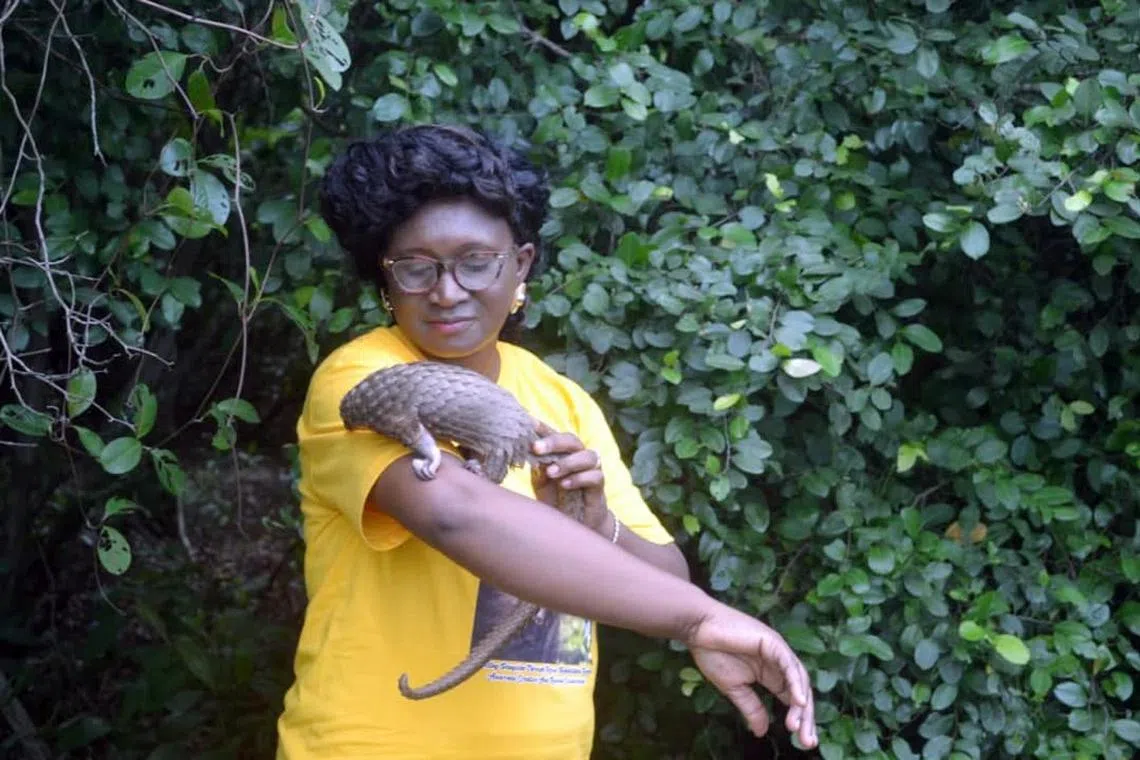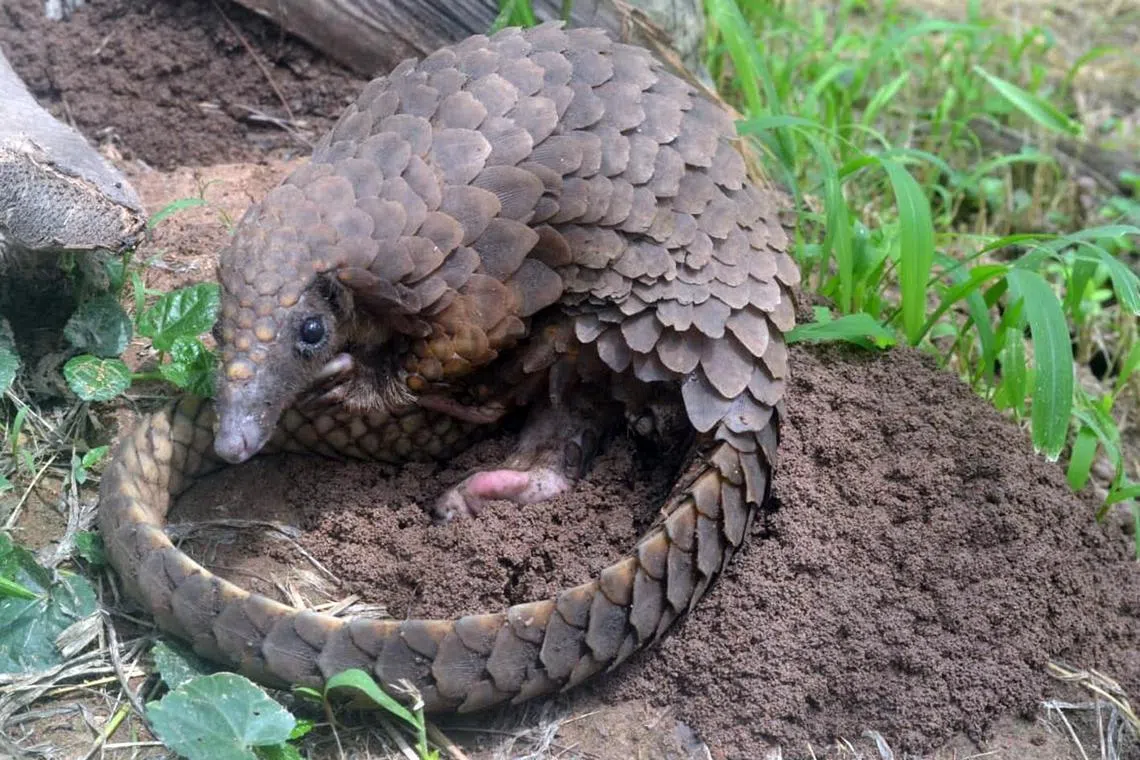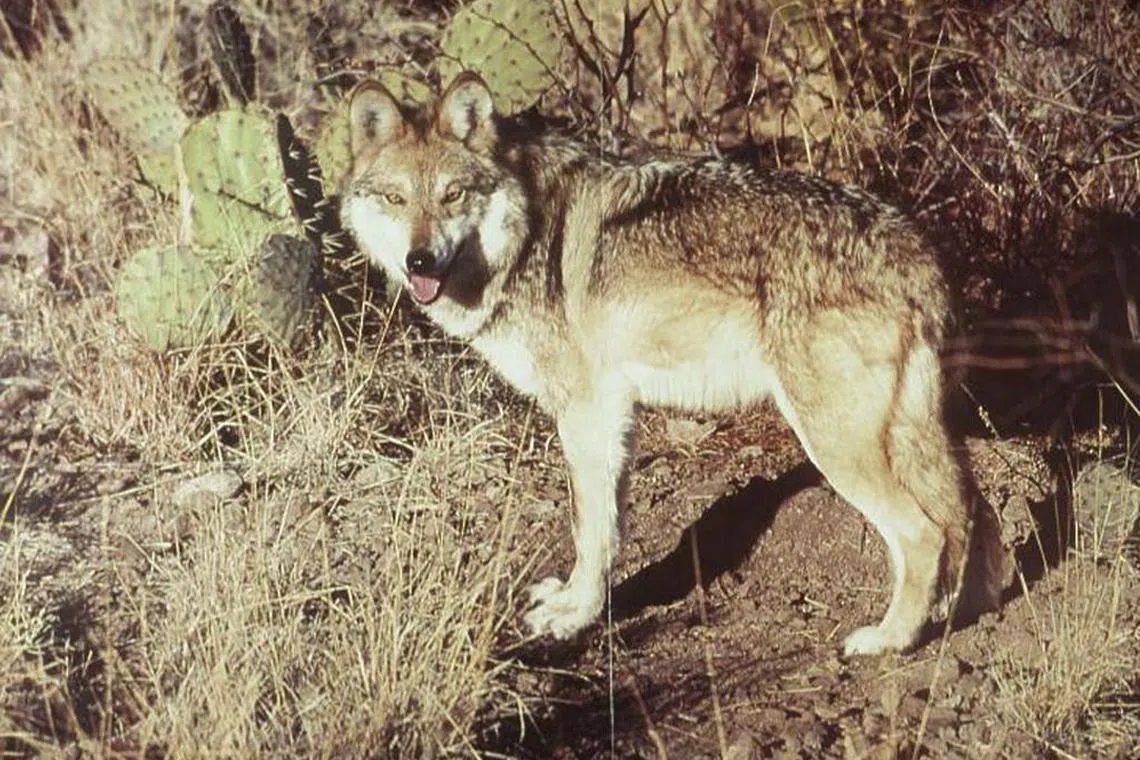Halting the biodiversity crisis
This is the third of a series of 12 primers on current affairs and issues in the news, and what they mean for Singapore
Sign up now: Get ST's newsletters delivered to your inbox

Professor Olajumoke Morenikeji, chair of the Pangolin Conservation Guild Nigeria, with a juvenile rescued pangolin.
PHOTO: PANGOLIN CONSERVATION GUILD NIGERIA
Follow topic:
The caller on the line told Nigerian zoologist Olajumoke Morenikeji he was at a restaurant where a mother and baby white-bellied pangolin were about to be slaughtered for food.
Professor Morenikeji asked him, a volunteer with her conservation group, to try and stop the killing. Meanwhile, another colleague drove four hours to the neighbouring state of Ondo to rescue the animals.
“Thankfully, when the caller told the restaurant owner that pangolins shouldn’t be eaten as bushmeat, the owner was compliant and released them to us,” said Prof Morenikeji, who chairs the Pangolin Conservation Guild Nigeria at the University of Ibadan in Oyo state.
Since 2016, her team has rescued nearly 100 pangolins from ending up among the more than one million killed in the global illegal trade over the last decade. Pangolins are the most trafficked mammals in the world, and Nigeria is the epicentre for pangolin parts smuggled from Africa to Asia, where its scales are prized, without any scientific basis, as medicine.
With eight species of pangolins native to Africa and Asia, the mammals are also hunted in many parts of South-east Asia and China.
Such over-exploitation of wildlife species, including poaching and trafficking, is the second-largest culprit of biodiversity loss after urbanisation and changes in land and sea use.
The other drivers are climate change, pollution and the spread of invasive species, says the Intergovernmental Science-Policy Platform on Biodiversity and Ecosystem Services (IPBES), the United Nations’ panel of biodiversity experts.
While species do become extinct, human activity is accelerating the rate of loss by between 100 and 1,000 times. About a million animal and plant species are now threatened with extinction, many within decades, said the IPBES in 2019.
The World Wide Fund for Nature’s 2022 Living Planet Report found monitored wildlife species had declined by an average of 69 per cent since 1970.
The planet has seen five mass extinctions before humankind, with the last one about 66 million years ago, which wiped out the dinosaurs.
Scientists say the world is living through its sixth mass extinction.
Why should we care about animals going extinct?
Each species of flora and fauna is a piece in a well-functioning ecosystem that supports life. If one species dies off, it affects the population of its predators and prey, putting pressure on the ecosystem and habitat.
The pangolin has many roles in the ecosystem. One animal feeds on an estimated 70 million ants and termites every year, noted Prof Morenikeji.
“That is a huge number. If this natural pest controller vanishes, we will run into problems. We don’t want a boom in ants and termites.”

Rescued White-Bellied Pangolin, which are the most common species in Nigeria.
PHOTO: PANGOLIN CONSERVATION GUILD NIGERIA
Species loss also threatens the existence of communities and indigenous groups that depend on and co-exist within ecosystems.
Prof Morenikeji said pangolins also mix and aerate soil through their foraging, improving soil health, and create burrows that other animals also use.
The connections are not always obvious. For instance, what does the durian have to do with disappearing mangrove habitats? Mr Muhammad Nasry, executive director of the Singapore Youth Voices for Biodiversity, says its flowers depend mainly on the cave nectar bat for pollination.
Mr Nasry added: “But durian season only comes once a year and the bats are mostly dependent on the nectar from the flowers of mangrove trees for the rest of the year.
“This means, no mangroves, no bats. No bats, no durians.”
A trajectory of destruction
The biggest driver of species loss today is habitat destruction, as forests and wetlands are cleared for agriculture and urbanisation. And as habitats disappear, animals may encroach on built-up areas, increasing the potential for human-wildlife conflict that could have tragic consequences.
Species face other threats as a result of human activity. Ocean pollution, for instance, has turned more than 400 coastal areas into inhabitable “dead zones” with a combined area larger than the United Kingdom.
Those “dead zones”, mainly caused by excess fertilisers and wastewater draining into the sea, lack oxygen for marine life.
Another threat is the spread of invasive species, which can outcompete native animals and reproduce quickly, threatening native ecosystems. In Singapore, invasive birds include crows and the ubiquitous Javan mynas, which reportedly arrived in the 1920s through the caged bird trade.
Climate change is another major cause of biodiversity loss.
For instance, coral reefs across the world are threatened by the warming and acidification of oceans. In seven years, Australia’s Great Barrier Reef was afflicted by four bleaching events that reduced vibrant corals to skeletons.
To tackle biodiversity loss, governments should put in place laws and policies that protect endangered species and vulnerable spaces, fund ecological restoration and conservation efforts, end subsidies for activities that degrade ecosystems, and shift to sustainable production and consumption, said the Living Planet Report.
On the ground, groups such as the Pangolin Conservation Guild Nigeria play their part. Its team of rescuers, vets, conservationists and students educates hunters, bushmeat sellers and community leaders on the ills of the illegal trade, and has seen a gradual decrease in pangolins being captured and sold.
Former poachers have turned rescuers. Prof Morenikeji is raising funds to help them find other sources of income through agriculture and animal husbandry.
Often at the forefront of conservation efforts, non-governmental organisations (NGOs) are vital in educating the public, doing research, and running habitat restoration and species recovery projects.
They are also advocates and watchdogs, especially when governments fall short in their policies and plans.
Ambitious global pacts
But it would take a much larger collective move to halt the scale of species destruction today.
In December 2022, nearly 200 countries at the COP15 UN Biodiversity Conference agreed to protect at least 30 per cent of the planet’s lands, oceans, coastal areas and inland waters by 2030.
This is a key target among 23 to be achieved by 2030 under the Kunming-Montreal Global Biodiversity Framework. The framework also covers four larger goals to be met by 2050.
Other outcomes under the framework include restoring degraded lands, protecting the rights of indigenous groups, increasing finance for developing countries, and by 2050, reducing the extinction rate and risk of all species by tenfold.
Currently, 17 per cent of the world’s land and 10 per cent of its seas is protected.
Protecting 30 per cent of the planet, discussed for several years by governments, has drawn parallels with the landmark Paris Agreement climate goal of capping global warming at 1.5 deg C above pre-industrial levels.
The Global Biodiversity Framework was followed by an international treaty in 2023 early March to protect the high seas, which lie outside national boundaries and comprise more than 60 per cent of the world’s oceans. Only about 1 per cent is currently protected.
The UN treaty could limit activities such as fishing, shipping and deep-sea mining that adversely impact the oceans.
Saving nature also helps fight climate change, since forests and oceans are natural carbon sinks that soak up planet-warming carbon dioxide.
If a third of the Earth’s forests, mangroves and peatlands is preserved, about 10 billion tonnes of carbon dioxide emissions can be avoided or sequestered a year, according to a recent study led by the National University of Singapore Centre for Nature-based Climate Solutions.
Keeping hopes up on the ground
The recent global pacts provide some hope that mankind can halt the sixth mass extinction. Numerous conservation and species recovery efforts are also showing promising results.
In 2022, the population of Mexican grey wolves, native to the south-west United States, crossed 200 after decades of captive breeding and reintroduction.
In the early 1900s, the wolves were killed in huge numbers in the southwest and in Mexico, to protect livestock.

Today, there are 241 surviving Mexican Gray Wolves, the most endangered of all gray wolves.
PHOTO: ARIZONA GAME AND FISH DEPARTMENT
Fewer than 10 remained in the 1970s, when captive breeding began. Their descendants were reintroduced into the US from 1998 and into Mexico from 2011.
While a far cry from the thousands that roamed the region more than a century ago, there are today 241 surviving Mexican grey wolves, the most endangered of all grey wolves, because of man’s efforts.
Conservation of species is not just the work of governments, NGOs and scientists alone. Individuals too can play their part. In Singapore, for instance, young people can sign up to be volunteers for biodiversity surveys or help with tree-planting efforts.
In Nigeria, Prof Morenikeji is not about to slow down her efforts. After a year of outreach at Epe Market – a major bushmeat bazaar in the state of Lagos – the sale of pangolin parts has been drastically reduced. The conservation guild will continue to monitor the market.
She said: “I am a positive person and I stay hopeful that the pangolins can be protected and conserved. I have a first-hand relationship with the animals. I’ve held them, I’ve nurtured them... And globally, the move to protect these beautiful animals is fantastic.”


